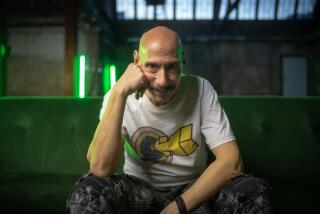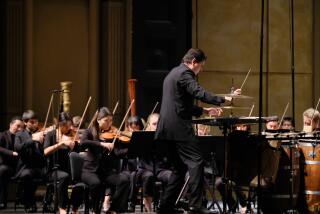POP MUSIC REVIEW : Sonic Youth Focuses Its Power, Soars
- Share via
IRVINE — As a stage band, Sonic Youth has reached sonic maturity.
The underground rock icons from New York City shaped and focused some of the most chaotic guitar sounds imaginable in a playful, authoritative and often exhilarating performance Saturday night at UC Irvine’s Crawford Hall.
On record, Sonic Youth regularly has achieved that sort of mastery at least since its 1986 album “Evol,” which established the band as a leader of the alternative rock scene. In concert, though, the band’s strengths were prone to be obscured by an overflowing surge of unharnessed sound. Now, its control and coordination seem complete.
The idea of making over-the-edge but coherent rock music out of clangor and electronic overload goes back to the Velvet Underground in the mid-’60s (and Sonic Youth played against a backdrop of projected colors and shapes that recalled the “Exploding Plastic Inevitable” multimedia shows that Velvets’ mentor Andy Warhol built around that band in its early days).
Without copying the Velvets’ sound, Sonic Youth provided a state-of-the-art embodiment of the rock-as-noise concept. Guitarists Thurston Moore and Lee Ranaldo used feedback howls, dissonances, twisted riffs based on unusual tunings and skewed playing techniques (a guitar doctored with duct tape for Ranaldo; a drumstick to scrape at or bang on strings for Moore at several junctures). These helped put the customary two-guitar blend on strange new footing.
Instead of dividing the guitar work into standard lead and rhythm roles, Sonic Youth was more concerned with spatial relationships. Moore usually played the foreground figures that were easiest for a listener to trace (drummer Steve Shelley often drove those riffs home by doubling the guitar cadences). Ranaldo, who chose from an array of about a dozen different guitars as if he were a golfer plucking the right club out of his bag, was the feedback master who wrapped his fellow guitarist’s strands in a broad fabric of sound.
This approach might sound a little measured and cerebral for a guitar-hero tradition that calls for grabbing the ax, turning its volume knob up to 10, and chopping away. But Sonic Youth was fun to watch. By the fourth song, for instance, Ranaldo had swung a 12-string guitar exactly like an ax, smashing it apart against the stage. Later, he held his guitar out to the audience as he shook groans from it, turning feedback into a sacrament.
Vocals, divided mainly between Moore and his wife, bassist Kim Gordon, were designed to serve more as added instrumental lines rather than as a conventional medium for pop melody. Moore had a bit of Tom Verlaine’s yelp in his delivery, while Gordon’s incantational singing was hoarser, more biting than on record.
Just about everything Sonic Youth played during its 70-minute set was taken at a hurtling, swarming pace, although less hectic eddys appeared at times, temporarily slowing the insistent, fast current. This method didn’t change much from song to song but once the band began clicking with its third selection, “Cinderella’s Big Score,” unswerving intensity made up for the lack of variety.
It was a show that needed no additions (although the band’s songbook easily could support a longer set without losing quality). But as Sonic Youth gets ready for its 10th year as a band, it still is working under a limitation that besets most ‘80s bands: excessive specialization. Sonic Youth has found a good niche for itself and has burrowed deeply into it, refining and amplifying the same approach with each album. The best rockers of the ‘60s and ‘70s were far more protean.
The Velvet Underground, for example, played some of pop’s most tender ballads--”I’ll Be Your Mirror,” “Sunday Morning”--when it wasn’t going on the noisy anti-pop excursions of a “Sister Ray.” Sonic Youth’s repertoire includes celebrations of rock’s power, odes to transcending the everyday grind, songs of spooky irony and pieces devoted to dark humor or black dread. But it hasn’t shown a hint of tenderness and warmth. Perhaps its method doesn’t allow it. But perhaps it would be worth finding new methods to explore.
Second-billed Mudhoney didn’t escape the trap that Sonic Youth bounded over with the sheer force of its playing--sameness leading to tedium.
The young Seattle band proved that it could hammer home ‘60s garage rock riffs culled from as far back as the Kinks’ “You Really Got Me,” along with some more recent-vintage punk thrashing. Everything about Mudhoney, including singer Mark Arm’s leathery howling, was raw and hard. That’s promising, but the band needs to develop more involving, less repetitious material.
Bassist Matt Lukin made the biggest impression--not for any musical efforts but for his foolish babblings between songs.
Lukin was back at it during Sonic Youth’s final encore, when members of Mudhoney and opening band Gumball joined in for a version of the Stooges’ “I Wanna Be Your Dog.” Lukin’s contribution to the sloppy but fun number was to drop his trousers.
Gumball was restrained but reasonably effective in a brief opening set that dredged up tougher ‘60s sources ranging from the Stooges to Jimi Hendrix to Neil Young. The proceedings could have used some of the humor and verve that come through on “Rake,” the latest album by Velvet Monkeys, a band in which two members of Gumball used to play.
More to Read
The biggest entertainment stories
Get our big stories about Hollywood, film, television, music, arts, culture and more right in your inbox as soon as they publish.
You may occasionally receive promotional content from the Los Angeles Times.











